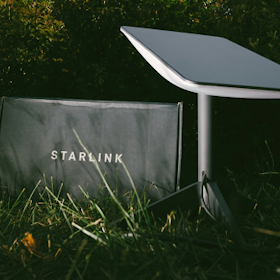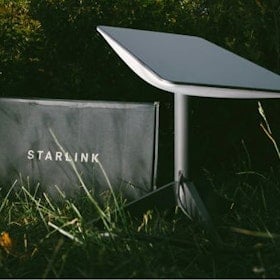If you recently moved, started working from home, or simply found a better plan, then you’ll need to set up your new internet hardware. While you could pay for professional installation, we don’t think that it’s worth the additional fee. With just a little know-how, self-installation is a cinch and will only take a few painless minutes. Luckily, we’ve got that know-how.
This guide’ll teach you the basics of self-installing your internet. Then, we'll provide detailed instructions for self-installing some of thhe most popular providers' internet plans, including Bell, Rogers, Telus, Eastlink, Starlink, and oxio.
If you're still looking for a new internet plan, we'll also break down some great offers from some of the best ISPs in Canada. Read on to learn more.
Self-install Bell fibre internet
Your self-install fibre internet kit will likely include a modem with a pre-connected cable and power cords. The steps for self-installing fibre internet vary based on what equipment you have at home.
Fibre jack
If you’ve got a fibre jack already installed in your home, installing Bell’s internet is rather simple. Follow the steps below, then enjoy lightning-fast speeds.
- Find the fibre jack located in your home.
- Grab your modem and remove the green connector from the white cable.
- Plug the green side of the white cable into your fibre jack.
- Connect the power cord to the modem and plug it into an outlet.
- Wait for at least 15 minutes while your modem activates.
- You’ll see three unblinking white lights when it’s ready.
- Connect to Wi-Fi using the name and password on the modem.
- Download your provider’s app, if applicable, in order to manage your Wi-Fi.
Optical network terminal
Optical network terminals communicate directly with internet service providers, ensuring fibre internet reaches your residence. Luckily, kickstarting your new Bell plan is easy with just a few simple steps.
- Find the optical network terminal already installed in your home.
- Disconnect it from the outlet.
- Loosen the screw underneath the yellow triangle on the back of the terminal.
- Unplug the green cable from the terminal.
- Insert the green-sided cable into the connector attached to your new modem.
- Plug the power cord into the modem and plug into the outlet.
- Wait for your modem to reboot. This may take up to 15 minutes.
- You’ll see three solid white lights when the modem is finished activating.
- Connect to Wi-Fi using the name and password located on the back of the modem.
Green cable
If you don’t recall a fibre jack or optical network terminal being installed in your home, things might be even simpler. Some residences receive their entire internet connection through a simple green cable. If that sounds like you, then be sure to follow the instructions below to get your internet up and running.
- Find your cable with a green end on it.
- Insert the green end into the connector already attached to the new modem.
- Plug the power cord into the modem and connect the modem to a power outlet.
- Wait for about 15 minutes until the modem has finished rebooting and you see three solid white lights.
- Connect to Wi-Fi using the network name and password on the back of your new modem.
Self-install Telus internet
When you order a self-install kit through Telus, it will take up to five business days to arrive. Telus recommends that you download the Telus Connect app to aid you in your installation at home. This app includes step-by-step instructions that make it easy to set up. Much like with Bell, your installation process will differ according to which equipment you have.
Telus Wi-Fi Hub
Telus’ Wi-Fi hubs are straightforward devices, intended to provide everyday users with a seamless installation experience. There aren’t many steps to install Telus’ hub, but you’ll want to make sure you follow them closely to avoid having to repeat the process.
- Choose a good location for the hub (out in the open, not behind walls).
- Connect the LAN/WAN port on the hub to Data 1 or LAN 1 on the fibre terminal using the Ethernet cord.
- Plug the power cable to the hub and plug it into a power outlet.
- The hub will be activated when the front light turns green and the light on top is blue.
- Connect all of your devices to the new internet.
Advanced Wi-Fi Modem
The setup for the Advanced Wi-Fi Modem is more complicated. This is a two-part process. First, you must install Optical Network Terminal (ONT) by following these steps:
- Find the fibre cable with a green connector.
- Remove the plastic top from the end of the green connector.
- Plug the green connector into the fibre connector.
- Open the door on the back of the hub.
- Plug the fibre connector into the modem.
Once you do that, you’re all ready to install your Telus internet by doing the following:
- Find an ideal location for the modem (out in the open, not behind any walls).
- Plug the power cord into the modem and plug it into an electrical outlet.
- Wait while the modem turns on.
- Once it’s complete, the front light will be green.
- Connect your devices to the internet, and you’re ready to go.
If you have a different modem than above, the steps will likely be similar to the Advanced Wi-Fi Modem steps.
Self-install Rogers internet
Much like the other ISPs, your self-installation steps may vary depending on what equipment you have.
Ignite WiFi Gateway Modem (Gen 2)
Like Telus’ devices, Rogers’ modems are designed for simple, intuitive set-up. Rogers makes the process a bit easier by allowing you to activate the service via your MyRogers account.
- Find the optimal place for your modem (central location, raised on a table or shelf).
- Register with MyRogers.
- Download the Ignite WiFi app and sign in with MyRogers username and password.
- Click Account on the top left.
- Under Devices, choose Activate Ignite WiFi Gateway.
- Wait approximately five minutes for setup to complete.
- Once it’s finished, the light on your modem will be blinking or solid white.
- If the white doesn’t turn white after this time period, try a different outlet.
- If the light flashes green then orange, then you need to wait 20 minutes for a software update.
- Connect your devices to your new Wi-Fi.
Most other modems
If you’re attempting to use another kind of Rogers modem, the exact instructions might vary. Most of them, though, follow the eight basic steps below.
- Choose the best spot for your modem (centralized location in an unobstructed area, on a shelf or table).
- Unwrap the new modem and use a coax cable to connect it to the outlet.
- Plug the power cord into the modem and plug it into a wall outlet.
- Wait a few minutes for the modem to activate.
- The @ symbol on the modem will stop blinking when it’s done turning on.
- Check the settings on your device to make sure the network is turned on and available.
- Connect to the Easy Connect Wi-Fi network.
- Open a web browser like Chrome or Safari and follow the on-screen steps to connect to the internet.
Self-install Eastlink internet
Eastlink’s self-install process is a lot simpler than its competitors. Here’s how to self-install your modem and set up your Eastlink internet connection at home:
- Set up your modem in a central location, out in the open.
- Plug the coaxial cable into the model and plug it into a cable outlet.
- Plug the power cord into the modem and plug it into an electrical outlet.
- You’ll know the modem is activated and online when it is showing four solid lights.
- Connect your devices to your Wi-Fi network using the username and password on the back of the modem.
If you have any problems while self-installing your internet, you can always call your ISP’s support line for help. You can also consult your smartphone app for tips or support.
Self-install Starlink internet
Starlink's popular satellite internet service does not have a professional installation option. All Starlink customers install the hardware themselves. Luckily, it's a rather straightforward process. Here's how to do it:
- Download and open the Starlink app.
- Tap Start Setup.
- The app will help you find an open, unobstructed area for your hardware. The Starlink dish needs to reach satellites in orbit, so avoid things like trees and buildings that might block it from doing so. Tap I’m Ready to find this area.
- After you’ve found a suitable location, tap I Have A Location.
- Follow the app’s instructions to connect the Starlink cable to the dish’s mast. Make sure you’re doing this in a dry environment.
- Position the Starlink dish and mast in the base.
- Your Starlink will begin rotating while it searches for a connection. When it finds a connection, it will tilt to its final position. If you’re in the northern hemisphere, it will tilt to the north. If you’re in the southern hemisphere, it will tilt to the south.
- Tap the button in the Starlink app that says Wi-Fi Settings.
- Follow the directions on the app to customize your Wi-Fi network configurations.
Self-install oxio internet
oxio is one of the best ISPs in Canada, with affordable plans, excellent service, and no hidden fees. It's a model that's propelled them to the top of our list of the best internet plans in Canada. If you're lucky enough to be a customer, here's how to can self-install their internet.
- Download the eero app from Apple or Google.
- Screw one end of the coaxial cable into the cable outlet in your wall.
- Screw the other end of the coaxial cable into the cable outlet on the modem.
- Plug the modem into an electrical outlet.
- Wait until all four lights (POWER, DS, US, and ONLINE/STATUS) on the modem light up.
- Plug one end of the Ethernet cable into the modem.
- Plug the other end of the Ethernet cable into the Ethernet port on the eero router.
- Plug the eero router into a power outlet. The eero router's status light will flash white.
- Open the eero app and create an account. (You can use a pre-existing Amazon account if you prefer.)
- Tap Next. The app will begin searching for your eero router. The eero's LED light will turn solid when the app finds it.
- Enter your network Wi-FI name and password.
- Tap Next.
- Your eero router and oxio internet are now ready to roll.
Find a new internet service provider
If you're looking for a new internet service provider, WhistleOut's search tool can help narrow it down for you, allowing you to compare plans from 27 different providers by download speed, data, brand, and connection.
We're also constantly tracking the best internet plans and internet providers in Canada, providing detailed breakdowns for how to score the best deals in the country. Right now, we're particularly impressed with oxio's Internet 100 plan, which offers 100Mbps downloads, 10Mbps uploads, and unlimited data for $57/month in Alberta, British Columbia, Manitoba, and Saskatchewan. It's even cheaper in Quebec, at just $45/month.
We're also fans of a more recent entry in the ISP game: Koodo. The Telus-powered brand is primarily known as a mobile carrier, but it began offering internet service this past year and, so far at least, we're impressed. It's an especially good option if you're looking to bundle your wireless and internet plans, with the Happy Stack deal offering discounts for customers who bundle those services.
Want to see more options? You can check out some of the most popular internet plans in Canada below.
Related Articles
Find Better Internet and Phone Plans
Hundreds of internet plans unpacked. All the facts. No surprises.
Internet Providers by Provinces and Territories
- Internet in Alberta
- Internet in British Columbia
- Internet in Manitoba
- Internet in New Brunswick
- Internet in Newfoundland and Labrador
- Internet in Northwest Territories
- Internet in Nova Scotia
- Internet in Nunavut
- Internet in Ontario
- Internet in Prince Edward Island
- Internet in Quebec
- Internet in Saskatchewan
- Internet in Yukon Territory



































